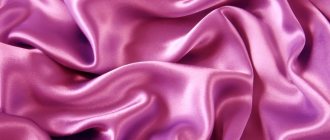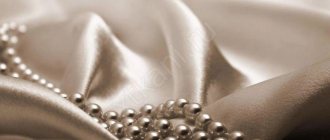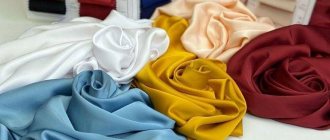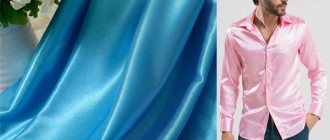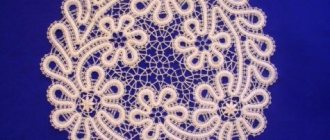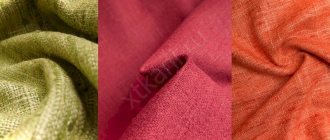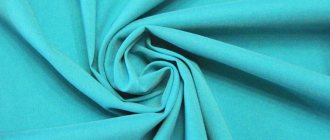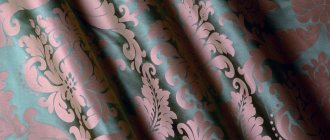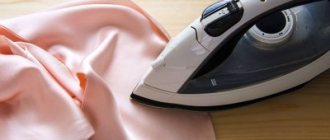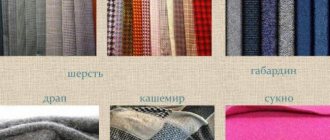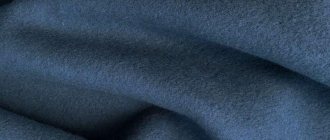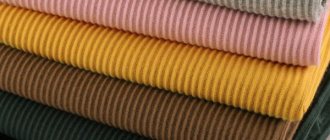Varieties of natural silk
The most delicate fabric is obtained from a continuous thread secreted by the secretory glands of the silkworm when curling the cocoon before it turns into a pupa. The type of silk produced depends on the type of silkworm. There are only two of them - Mulberry silk and Tussa silk.
Mulbery is the best variety of silk, which is obtained from the smooth, thin thread of the silkworm, domesticated about 3,000 years ago. This variety is also called mulberry silk or “cultivated silk.”
On special farms, a large and fluffy moth is artificially bred and raised, which over the years of selection has forgotten how to fly and has become blind. Its only purpose is to lay eggs and die. The emerging caterpillars are fed only mulberry (mulberry) leaves. Before turning into a pupa, they release a single long thread, which they wrap around themselves in the form of a silk cocoon.
The process of growing caterpillars, silk cocoons and further processing of silk thread is complex. Many operations are still performed manually. Therefore, Mulberry silk is quite expensive. Most silk fabrics are produced from it: crepe, toile, satin, crepe de Chine, chiffon and others. Initially, the canvas turns out to be milky in color (ivory, bleached). It is then stamped.
Tussa silk is made from yarn woven from wild silkworms. A wild butterfly, unlike the domesticated silkworm, can fly, lives in the wild in natural conditions and continues its genus. Its caterpillars feed not only on mulberry leaves, but also on any vegetation.
The threads from the cocoon of a wild silkworm are not wound manually, as in the first case, but are combed. The thread turns out to be not quite thin and even, with thickenings and irregularly shaped interceptions in some places. Therefore, the fabric produced from it is heterogeneous in structure. The tussah silk group includes fabrics such as dupont and chesucha. The canvas can be unpainted, patterned or painted.
The rich history of the fabric of emperors: legends and reliable facts
In China, the land of the sun, they are very fond of various legends. It was this country that became the birthplace of thread mining, where the history of the well-known material began. According to one famous legend, sericulture dates back to the reign of the Yellow Emperor. The main wife of this mythical ruler allegedly revealed to the residents the secret of breeding amazing caterpillars, weaving threads from silkworm cocoons and how silk is made. For this, the empress was named Xi-Ling-CHI, which means the mistress of silk worms.
The entire reign of the Yellow Emperor is saturated with a variety of myths and legends, and considering how much the Chinese love to attribute all important world events to their rulers, it is quite difficult to say how things were in reality. There is another legend according to which women collected fruits from trees and put them in baskets. The resulting harvest contained white, hard fruits that were unsuitable for consumption.
The women tried to boil the fruits received from the country, and after that they began to beat them with sticks to soften them. In the process, they noticed that thin white threads remained on the sticks. The production of silk threads in ancient China began this way.
In addition to the numerous legends of China, there are also real facts about the beginning of the extraction of silk threads. Archaeologists have proven that the secret of silk weaving was known to people back in the era of Neolithic culture. In excavations in various Chinese provinces, ancient manuscripts were discovered that mentioned hieroglyphs for silk, cocoons and mulberry, as well as scraps of fabric. In the 3rd century BC, more than 5 states of present-day China operated small workshops for the extraction of silk threads and products from it.
In the 2nd century BC, a unique silk road was laid that stretched from East Asia to the Mediterranean. The main product of the Asians, of course, was silk. For many thousands of years, China has been recognized as a monopoly producer of amazing fabric. Soon the secret of creation became known to Japan, and then to Byzantium. During the period of the Crusades, the secrets of silk production reached Europe.
Types of silk
Different silk fabrics differ from each other in properties, texture, and the method of weaving the threads used in their manufacture.
Plain dyed silk
The fabric is spun from weightless, undamaged long thread from the best silkworm cocoons using the tight twist method. This type of silk is of the highest quality.
Silk cambric
Durable, light, thin material is obtained from tightly twisted threads using plain weave. Silk cambric contains approximately 3% silk. For this reason, its cost is much lower than pure silk fabrics. And it’s easier to work with.
Organza
The moderately stiff, airy translucent fabric is made from tightly twisted silk threads using plain weave. The texture can be glossy with an iridescent effect, matte, with embroidery, printed with printed designs, plain-dyed, or pressed. They use it to make curtains, concert dresses, and costumes for oriental dances.
Atlas
Silk satin is a durable, dense, expensive fabric. Requires delicate care. Shiny on one side and slightly rough matte on the other, it is produced using the satin weave method invented in China. The material is most often smooth and glossy. They also produce patterned, moire, heavy and other subtypes of satin.
Silk satin
The fabric belongs to the satin group and is distinguished by its beautiful shine and dense, smooth surface. They produce durable material from a mixture of silk and cotton sateen. It is cheaper than silk.
Crepe
Crepe is the general name for a group of silk fabrics made from weft and warp threads, twisted with varying degrees of tension, resulting in a textured relief structure of the fabric. The name of the material in translation sounds like “wavy, rough” (from the French word “crepe”). The fabric wrinkles little, drapes well and fits into beautiful folds.
The group of crepe materials includes crepe satin, crepe de Chine, crepe chiffon, crepe georgette and others.
Crepe de Chine
Thin silk fabric with an uneven grain structure is produced from crepe twisted threads using the plain weave method. A characteristic feature of this material is flowing soft folds and draperies.
Crepe georgette or georgette
Silk fabric with a rough and shiny front surface. Feels like flowing sand. It is made from tightly twisted threads in different directions using crepe weaving. Due to this, the fabric is light, but quite elastic and dense.
Gas
This is a group of weightless, transparent and very thin fabrics obtained from natural silk or cotton threads by interlacing one weft thread with two warp threads. The lightness and airiness of silk gauze is ensured by weak weaving, which can be smooth, patterned, or diagonal. Depending on the type of weaving, methods of processing raw materials and dyeing, the following types of gas are found.
Gas illusion
Almost transparent and very thin material. It looks almost like a weightless cobweb. Made from very fine silk yarn. Used for sewing curtains, light gauze scarves, and for making wedding accessories.
Gas-rice
A delicate, light fabric, slightly rough to the touch, is produced using rice weaving from untwisted threads of raw silk.
Gas-crystal
Fabric with an iridescent multi-colored surface of the canvas. Bright shine is achieved by weaving threads of different colors in the weft and warp. An excellent option for sewing ball gowns.
Gas marabou
A more rigid fabric compared to gas-rice fabric. Although both types are made from raw silk, gaz marabou uses tightly twisted threads. A characteristic feature of this fabric is its golden color, reminiscent of the plumage of a marabou bird.
The material was especially popular at the beginning of the 18th century, when secular fashionistas sewed lush dresses from it.
Taffeta
The name of the fabric translated from Persian Taffeta means “twisted, woven.” The thin, shiny material is produced from natural silk or cotton threads using plain weave from highly twisted threads. Sometimes synthetic fibers are added to the composition. During the finishing process using chemical components, the fibers acquire rigidity and density. Due to this, the thin fabric holds its shape well and forms voluminous, brittle folds. But at the same time it wrinkles a lot.
Taffeta can be printed, plain, crinkled, tapestry, smooth. Evening dresses, curtains, outerwear, and petticoats are made from it.
Chiffon
Delicate, thin material is obtained from tightly twisted silk threads using plain weave. The flowing, airy material looks great in women's summer clothing. Varieties of chiffon - satin chiffon, pearl chiffon, jacquard chiffon, crepe chiffon.
Toile
Translated from French, “toile” means a general name for a dense material with a delicate shine, woven using plain weave. The fabric holds its shape perfectly. Ties and dresses are made from it, and used as lining.
Cadi
Another subspecies in the group of silk materials. The main component in its composition is silk. Viscose, elastane, polyester, acetate, and polyacrylic are often added to silk fibers. Real silk cadi is expensive and is not found very often.
Translated from French, its name means “flowing water.” Apparently because the matte surface visually resembles the surface of water. The material is heavy, dense, and has almost no stretch. And at the same time it is a flowing plastic material that perfectly retains its shape.
Foulard
Soft thin silk fabric is most often used as a finishing material. Scarves, kerchiefs, and scarves are made from it. Batik masters love to work with this material, on which paints adhere perfectly.
DuPont
The fabric consists of almost 100% natural silk fibers. Belongs to the category of dense materials with a glossy surface of medium hardness. It is used to make expensive bed linen, curtains, accessories, evening and wedding dresses.
Brocade
Silk brocade is a heavy decorative fabric on a silk base with a complex pattern made with metallized lurex thread imitating silver and gold, which were originally used in rich fabric made from thick silk threads. Nowadays silk, cotton and linen threads are also used for embroidery.
Charmeuse
Silk with a characteristic shine on the face and a matte surface on the back. The fabric is like satin. But unlike it, charmeuse is softer, thinner, and fits better to the figure.
Muslin
Thin, transparent fabric made from natural silk threads is similar in appearance to cambric. The material is made from high-twist threads using plain weaving. They make ball gowns, theatrical costumes, scarves, and negligees from it. The name is translated from French “mousseline” as muslin.
Silk veil
The name of the translucent smooth fabric translated from French “Voile” sounds like “veil, haze”. It is produced from silk yarn in the form of dyed, bleached, printed fabric, with lace and embroidery. The structure is softer than organza. Looks good in decorative and wedding accessories.
Chesucha (wild silk)
Dense clothing fabric with an uneven texture is formed due to the use of threads of different thicknesses in the fabric. It is made from yarn obtained from the cocoons of wild silkworms - tussah. The color of the canvas is yellow, without a pattern. The structure is durable. At the same time, soft enough to drape well. The material requires special care.
Silk epontage (ponge)
A material with a spongy, uneven surface is produced from silk or cotton fiber using a plain weave method. It is characterized by a rough surface with a geometric color pattern in the form of stripes, checks, and melange. Children's and women's dresses are made from this fabric.
Silk velvet
The fabric has been known on the textile market since the 18th century.
Twill
Strong, thin fabric is produced by diagonally weaving twisted threads in the form of a printed or plain-dyed fabric. From a material in which both sides are right: one is smooth, shiny, the other is matte, crepe, they sew workwear, use it as a technical fabric and as a lining.
Excelsior (excelsior)
Beautiful fabric, transparent, with a bright characteristic shine, soft and light. It is made from untwisted silk thread using plain weaving. Decorative elements and flowers are made from fabric.
Duchess
This is a high quality dense shiny satin made from silk fibers.
Lace
There are many varieties of lace. Whatever the technology and whatever material they are made from, the material is delicate and quite difficult to work with.
Wet silk
After washing, the fabric acquires a “peach” surface with a slight fluff. For this reason, wet silk is sent to dry cleaning. It cannot be rubbed or washed.
Matlasse
Double fabric with a jacquard, seemingly “quilted” pattern is made from natural silk fibers.
Viscose
In the production of this fabric, which retains the properties of natural material, synthetic fibers are added to silk threads.
Production of natural silk
It is impossible to give an exact date when people learned to use threads from silkworm cocoons to make fabric. An ancient legend says that one day a cocoon fell into the tea of the Empress of China - the wife of the Yellow Emperor - and turned into a long silk thread. It is believed that it was this empress who taught her people to breed caterpillars in order to produce fabric unique in its composition. The ancient production technology was strictly classified for many years, and for disclosing this secret one could easily lose one's head.
History of silk
The idea of using silkworm threads to produce noble and exquisite fabric first originated about five thousand years ago in China. It is there, in the homeland of silk, where the secret of sericulture and the special technology for obtaining mulberry silk were carefully kept for many years in the strictest confidence, that the highest quality fabric is still produced. Its name indirectly confirms the origin of the material. Literally, silk (silki) is translated from Scandinavian as fabric from China.
At first, the most delicate fabric was produced only for members of the imperial family and only in the palace. And it cost fabulous money. Nevertheless, along the caravan road, named after the main product of that time, the Great Silk Road, valuable fabric was uninterruptedly exported to other countries. Along with Chinese tea, porcelain, spices, cosmetics, rice.
However, over time, everything secret becomes clear. And gradually the Chinese ceased to be the only producers of silk fabric. The secret, along with mulberry seeds and silkworm eggs, leaked to other countries. Mulberry silk began to be produced in Korea, Japan, Byzantium, India, Arab countries, and later in Europe.
Little spinner: more about the silkworm
The silkworm and its silk production are a truly unique natural process. Today, the insect is grown specifically to create elite tissue. The butterfly is quite large in size and at least 5 cm long with a similar wingspan. Despite developed wings, specially raised individuals do not fly.
Interesting! This butterfly does not know how to eat and experiences hunger throughout its life. This fact is explained by the underdevelopment of the mouth and other digestive organs.
How is natural silk produced?
Modern technology for the production of silk fabric is not much different from that used by the Chinese thousands of years ago. This process is painstaking and requires constant attention. Although some operations are certainly automated.
The full life cycle of a silkworm, the main producer of raw materials for silk fabric, takes an average of two months. The butterfly lays eggs (greens). Their number reaches 500 pieces. Depending on the selection, they are Chinese, European, Asian, Japanese, Cypriot, Persian.
Greens in the process of making silk fabric are of particular value. At rest and under certain conditions, they remain viable for two years. If it is necessary to revive them, the temperature in the incubator is gradually increased and on days 7-12 very small (up to 2 mm) silkworm worms appear from the eggs. For a month, all they do is constantly eat and grow quickly. To feed the voracious worms, huge mulberry plantations are grown.
An adult individual transforms from a two-millimeter worm into a caterpillar 5-7 cm long. It can form a thread up to 1 km long. To do this, the caterpillar curls a cocoon on a branch and begins to secrete a viscous substance with its secretory glands, which instantly hardens in the air and turns into a thread. The pupation process takes two to three days.
After the cocoon formation is completed, they are sorted. The main part goes to fabric production. The best specimens are left for subsequent production of offspring. After 12-15 days, a silkworm butterfly will emerge from them, lay eggs and die.
Cocoons selected for production are poured with boiling water to free them from the sticky viscous substance - sericin. Then the thinnest thread is carefully rewound from the cocoons onto the bobbin on reel machines. To obtain a thick fabric, up to 20 fibers are joined together. For thin fabric, it is enough to connect 5-8 fibers.
Finished threads in skeins are called raw silk. They are first painted. Then they are sent to the looms to weave silk fabric.
Interesting numbers: 1000 cocoons are required to sew a silk women's dress. And to raise 1000 caterpillars you will need two or three mulberry trees or approximately 60 kg of leaves.
How are silk threads created?
Despite the capriciousness and whimsicality of care, silk products are extremely popular. Silk fiber is a secretion product of silkworm caterpillars. Silkworms are specially bred in sericulture farms. There are four stages in the development of the silkworm: egg, caterpillar, pupa, and butterfly.
Protein metabolism takes place in the caterpillar's body. The proteins of the mulberry leaves, under the influence of enzymes in the caterpillar's digestive juice, break down into individual amino acids, which in turn are absorbed by the caterpillar's body. Next, the transformation of some amino acids into others occurs.
Thus, by the time of pupation, a liquid substance consisting of various amino acids necessary for the creation of silk - fibroin and silk glue - sericin accumulates in the body of the caterpillar. At the moment of cocoon formation, the caterpillar secretes two thin silks through special ducts. At the same time, sericin is also released, i.e. glue that sticks them together.
The caterpillars that emerge from the testicles are no larger than 2 mm in size; after 4-5 weeks they reach 3 cm. The process of creating a cocoon takes 4-6 days, while the caterpillar, as scientists have calculated, must shake its head 24 thousand times to build its dollhouse. This is how the silkworm transforms into a pupa.
Together with the pupa, the cocoon weighs 2–3 grams. Then, after about two weeks, the transformation into a butterfly occurs, which is as inconspicuous as a moth.
But turning into a butterfly in silk production cannot be allowed, since it, trying to break free, will spoil the integrity of the silk thread. What are they doing? The cocoons are fried in an oven, then treated in a chemical solution, sometimes in ordinary boiling water. This is done so that the sticky substance evaporates and the cocoon collapses and disintegrates into threads.
These caterpillars are not only the creators of silk, but also served as the prototype of spinnerets - mechanisms for forming artificial silk thread. If you carefully observe the phenomena occurring in nature, you can discover a lot for yourself, and you can’t imagine anything better than nature.
Currently, in addition to China, many countries are engaged in silk production: India, Japan, Korea, Thailand, Uzbekistan, Brazil and many others.
Features of natural silk production
Sericulture is a very delicate industry. It consists of several stages:
1.
Obtaining silkworm cocoons. A female silk butterfly lays approximately 500 eggs. They are sorted, leaving only healthy ones. After 7 days, small silkworm caterpillars appear, which are fed with mulberry leaves, having previously been selected and crushed. Then the caterpillars begin to spin cocoons-houses. This happens for several days until they completely twist themselves. After which they are again sorted by color, shape, size.
2.
Unwinding of cocoons. The pupa is killed so that it does not have time to hatch and damage the cocoon. The cocoon is then immersed in boiling water to dissolve the sticky substance and separate the threads.
3.
Creation of silk threads. One cocoon can produce up to 1000 m of thread. Up to 5-8 threads are twisted into one fiber, resulting in a fairly long silk thread. This produces raw silk, which is then wound into skeins. And again they are sorted and processed until better density and uniformity. Now you can send it to the weaving factory.
4.
Fabric making. The yarn is soaked and processed and dyed again. Now the weaving begins, using various weaves.
Chemical composition of silk
The cocoon thread or silk that the silkworm secretes, when examined under a microscope, looks like a double thread consisting of two single threads glued together with the substance sericin. Its chemical composition is similar to that of human hair. Consists of 20-30% of the sticky bioactive substance sericin. The second main component in the thread is the protein insoluble fiber fibrion (70-80%). It also contains about 3% fat, wax, amino acids, sodium and potassium salts.
Silk products made from yarn with a similar chemical composition have bactericidal and hypoallergenic properties and have a good effect on human skin, stimulating cell regeneration in a natural way.
Properties of silk fabric
- The fabric is highly breathable, ensuring free air circulation.
- Natural thermoregulation – the temperature of silk fabric provides comfortable conditions, adjusting to body temperature.
- Hygroscopicity - silk fabric absorbs moisture well and dries quickly.
- Wear resistance - for many years the fabric does not lose its quality and attractive appearance.
- The white and beige natural color of the yarn can be easily dyed into any shades and colors.
- It wrinkles, but without the formation of unsmoothed folds and creases. And it quickly straightens out on its own.
- Not electrified.
- The fabric is not flammable. When fire hits silk clothing, it smolders slowly, without immediately flaring up.
- The optical effect of the triangular cross-section of the silk thread, which reflects and refracts light, gives the material a special sophistication.
- Excellent hygienic characteristics - dust mites do not breed on silk clothes.
- Silk clothing does not cause allergies.
Advantages and disadvantages
Fans of the most delicate fabric note in their reviews the quality indicators and advantages, as well as disadvantages characteristic of all types of silk fabrics:
the fabric is pleasant to the body, does not irritate the skin, it is pleasant to wear silk clothes in any weather;
I like the delicate texture of silk, the flowing smooth surface;
The variety of colors is impressive, stable bright colors that are perfectly preserved on silk fabric.
natural silk reacts poorly to prolonged exposure to ultraviolet radiation - the sun's rays destroy the fabric;
stains and streaks remain on the surface of silk fabric when any liquid comes into contact with it: clean water, raindrops, sweat;
Caution is required when ironing silk items - with prolonged exposure to the fabric during ironing, the structure of the fabric becomes fragile and loses its elasticity;
high cost is another significant disadvantage.
What standards are used in production? What do they take into account?
The produced silk fabrics must meet developed and approved standards in terms of their quality indicators. These are GOSTs and technical conditions.
For silk fabrics for household use, regardless of the fiber composition, general indicators are included in GOST 4.6-85 - these are width, surface density, fabric density per 10 cm at warp and weft, breaking load, color fastness in points and artistic and aesthetic indicators. Non-compliance of fabrics with the approved standard is considered a violation of the standard (GOST 15.007-88).
Where are silk fabrics used?
The main direction where natural silk has retained its undivided dominance over other fashionable fabrics is tailoring. Silk textiles offer unlimited possibilities in creating various models of women's, men's, and children's clothing.
Excellent draping silk fabrics look great in the interior. Silk bed linen, curtains, bedspreads, and decorative accessories are made from light flowing fabric. More dense types include furniture covers and curtains.
Bactericidal silk thread is used in medicine. It is used in surgery as a suture material. The amino acid it contains disinfects the wound and accelerates healing.
Silk care rules
The basic rule is to strictly follow the recommendations for caring for silk items, which are indicated on the clothing label for a specific type of fabric from this group of fabrics.
Hand wash recommended. In this case, the fabric should not be rubbed or twisted too much when squeezing. If washed in a washing machine, then only with the “gentle wash” mode set. It is advisable to use gels for delicate fabrics when washing. It is better not to use fabric softeners.
Do not wash in hot water. Maximum – up to 40 degrees. The protein component included in the thread is destroyed at high temperatures. To reduce the impact of an alkaline environment when rinsing, you can add table vinegar to the water (100 ml of 9% vinegar per 10 liters of water).
Squeeze carefully with your hands. Dry flat, avoiding exposure of the material to sunlight. Iron from the inside out on the “silk” setting, avoiding water droplets getting on the fabric.
Do not spray perfume, deodorants, or hairspray on silk clothes.
Expert advice
Natalya Kadatskikh
Designer, fabric expert with 20 years of experience
Natural silk can shrink slightly when washed (even not the first time). To prevent your favorite silk dress from being a little tight, it is recommended to decate the fabric before cutting and sewing. Decatting is a wet-heat treatment of fabric in order to prevent its shrinkage during working with it and during further wear. In practice, this means that new fabric must be washed and ironed, taking into account the care recommendations for each specific type of silk. As a result of these actions, the material will shrink. At home, you can use a regular iron for decaling. To prevent traces of water droplets from remaining on plain silk fabric, it is better to iron the fabric with a warm iron without steam from the inside out.
How the fabric is obtained
The prepared and sorted threads are used to create silk fabric.
First, several threads (from 3 to 15 pieces) are twisted into one to increase the strength and stability of properties, then they are threaded into a weaving loom and the weaving process is started.
When leaving the machine, silk fabric does not shine with beauty: it contains impurities and contaminants, various irregularities and defects. She will have to go through several stages to improve her appearance:
- Boiling in a soap solution at a temperature of 94-95 °C for 2-3 hours - this removes all traces of fatty substances and sericin particles.
- Exposure for 10-12 hours in hydrogen peroxide at a temperature of 65-70 °C - to obtain white silk.
- Treatment with acetic acid solution at a temperature of 29-30 °C for 15-20 minutes - so that the fabric becomes soft.
- Printing using the airbrush method, when dye is applied through holes in a mesh template or stencil using a spray bottle.
- Final finishing is steam treatment and drying on a needle shrink-treading machine.
After all these procedures, silk fabric becomes softer and more elastic, acquires shine and richness of color.
How to distinguish natural silk from fake
It’s easy to get confused in the variety of silk fabrics. And you can run into a fake by buying imitation natural silk for a lot of money. Many synthetic “silk” fabrics, at first glance, differ little from real silk. Especially if there is no marking on the fabric. The following signs will help you clearly understand that this is real silk and not a fake:
- We focus on price - silk is always more expensive than synthetic analogues. Although this is not the main sign.
- Soft, delicate, flowing, as if “flowing” from the hands, delicate silk is much more pleasant than artificial silk, which is harder to the touch and colder in sensation.
- Natural fabric is hygroscopic. The same cannot be said about synthetics.
- Mulberry silk adapts to the temperature of the human body when in contact with the skin - synthetics do not have such unique thermal properties.
- The natural, slightly subdued shine of natural silk shimmers and changes shades in different lighting conditions. Artificial fabric also shines, but its color does not change.
- Silk, like all natural fabrics, wrinkles, but not very much. The resulting folds are soft and quickly straighten. The creasing of artificial silk is more pronounced - the resulting creases are difficult to smooth out even with an iron.
- Synthetic fabrics, unlike natural ones, fray heavily along the edges of the cuts.
A small experiment with burning several threads pulled out of the fabric will allow you to verify the authenticity of the material. If the material is natural, the threads will burn slowly, giving off the smell of burnt wool. In this case, the resulting ash immediately crumbles. Synthetics melt quickly. An unpleasant plastic smell appears. The combustion product is baked into a lump. If it is viscose silk, the threads burn with a bright flame, emitting the smell of burnt paper and crumbling into fine light ash.
Despite the high cost, which by the way is quite justified, clothes made of silk material, fascinating with its special smoothness and bright colors, deservedly enjoy the love of customers.
